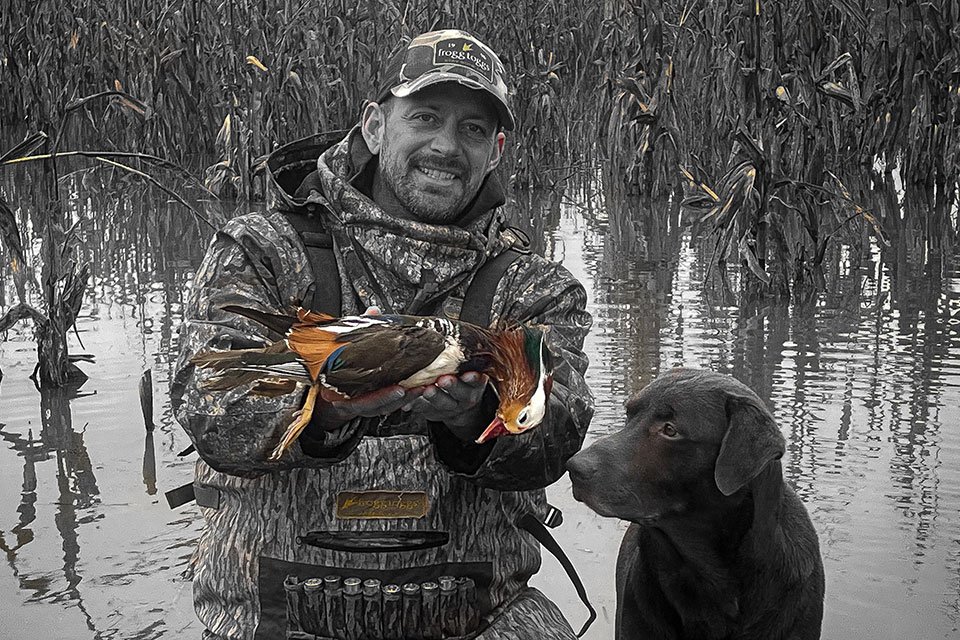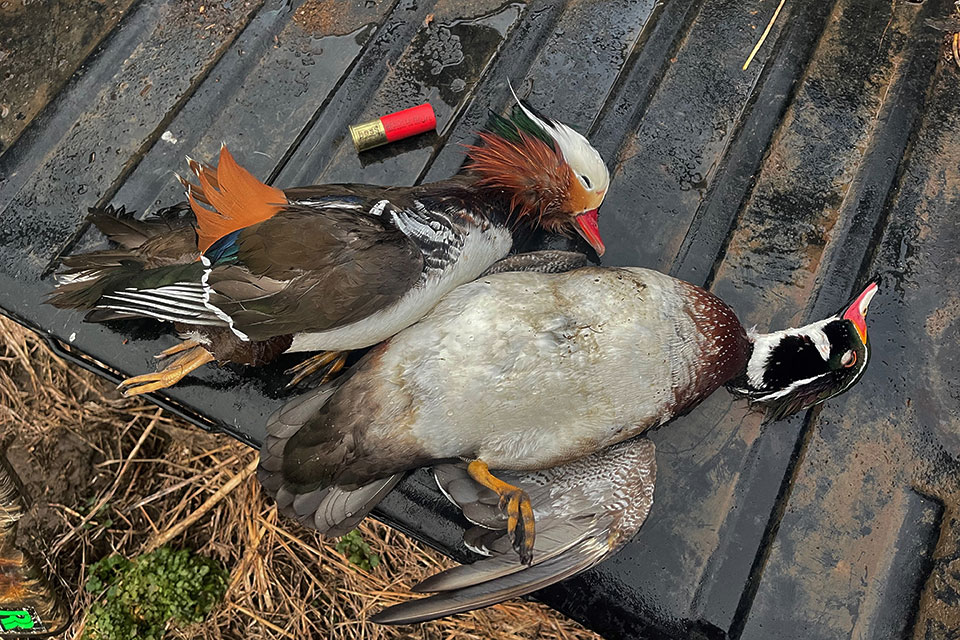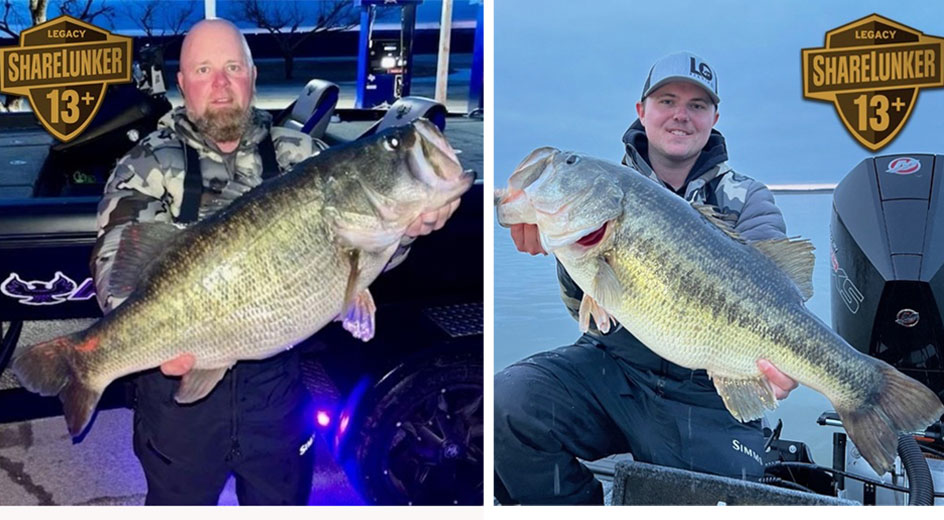
Duck season went rather well for Bassmaster Elite Series pro David Mullins, who harvested the rarity of a drake Mandarin duck.
“That’s the first one I’ve ever seen,” Mullins said. “It’s probably a once in a lifetime thing. I’ve hunted since I was 13 and I’m 42 now. It’s the first one I’ve laid eyes on.”
Closely related to North American wood ducks, the colorful Mandarins have a native range in east Asia, mainly China, Japan and Russia. They were introduced and thrive in Britain and Western Europe, Wikipedia reports.
There have been reports of Mandarins in the U.S., including one that drew national attention as it took up residence in New York’s Central Park in 2018-19. People called it Mandarin Patinkin.
“I think there’s probably isolated, small populations across the U.S., mixed in the wood ducks somewhere,” Mullins said. “It’s pretty wild.”
Mullins nailed it. There’s a population in Sonoma County, Calif., which bred after escaping captivity. About 100 miles south of Mullins’ hunting farm in Mt. Carmel, Tenn., a small flock of Mandarins live around Black Mountain, N.C.
Mullins’ bird came out of the blue, most likely from that group.
“I saw it one afternoon after church,” he said. “I was checking my water pumps, looked out and it was by itself. I knew exactly what it was. A friend of mine that helped me farm and hunt, he shot a pair about 15 years ago.”
That evening’s attempt to hunt it was futile. Mullins said he never could get a shot.
“About five or six days later, he showed up again with some wood ducks at the same spot,” he said. “I came real close to killing him that day. Then I hunted the next morning right there, but he didn’t come back.
“The next day, I said this is the last morning I’m spending on it. I’ll be danged if he didn’t fly in there, and I shot him.”

The Mandarin and wood duck are the only members of the genus Aix, and its species, galericulata, means small, capped head. Both have ornate plumage.
“It kind of looks like a rooster mated with a wood duck,” Mullins said. “Wood ducks are real pretty too.”
Among the biggest Elite duck men — he’s hunted around 50 days in the 60-day season — Mullins floods acreage of rice and corn. Sometimes when the weather is right, he’ll hunt the nearby South Fork Holston River.
“When everything freezes, I own a couple islands on the river we hunt,” he said. “If Rusty Creasey calls me on Coca Cola Woods and he’s got an open slot, I’ll go up and hunt with him occasionally.”
Creasey manages the famed duck club near McCrory, Ark. Mullins said the flooded timber along the Mississippi Flyway is one of the most prestigious places to hunt in Arkansas, proclaimed the Duck Capital of the World.
“When I ain’t hunting here and I get an invitation, I go there,” he said. “We don’t have the consistency here to guide. We’re just a sneaky flyway in the mountains. When it’s good, it’s as good as it can be anywhere. When it’s slow, it’s a lot slower than places that have populations.”
Mullins will soon be switching from duck boats to his bass boat, which he’s had delivered and wrapped but still has some rigging. An Elite since 2014, Mullins was second in the Progressive Bassmaster Angler of the Year race in 2020. He qualified for four consecutive Classics before missing last year.
“Last year, I couldn’t catch a bass,” he said.
Why was that?
“No clue,” he said.
It wasn’t his lack of forward-facing sonar knowledge. Being on the Garmin pro staff, Mullins was among the first to use it. Mullins has even been called upon to use his electronics in rescue and recovery missions.
“Unfortunately, I’ve done that. Not something I want to do a lot, but I help out rescues as much as I can,” he said, relating one specific incident. “There was a guy who jumped off a cliff here in the summer for fun with a group of people. Apparently, he hit the water so hard, it knocked him out and he drowned. They looked for him all that evening. Couldn’t find him.
“His family called me. I didn’t know any of them, but they knew me. I went and found him in like 30 seconds, as soon as I got to idling around. They sent the diver down, 15 minutes later he come up with him. If you ain’t ever seen a sight like that, it ain’t good. It’s terrible.”

Texas lunkers show up in big way
The bigger in Texas slogan is proving itself once again. That could be a good omen for the Elite Series, which is opening the year with two events in the Lone Star State.
Last Monday, there were two Toyota Legacy Class ShareLunkers from O.H. Ivie Reservoir entered into the state’s famed stocking program. Mineola anglers Lane Olson and Bobby Waldon caught largemouth over 13 pounds, continuing that lake’s run of 15 Legacy bass in 2023 and 41 in the past four seasons.
Olson caught a 13.26-pounder, and Waldon landed a 14.75-pound beast.
“This is the second year in a row that O.H. Ivie has produced two Legacy Class ShareLunkers in one day during the collection season,” said Natalie Goldstrohm, Toyota ShareLunker coordinator.
Despite frosty conditions, Elites showed off some big bass in pre-practice. The season gets under way Feb. 22-25 at the Gamakatsu Bassmaster Elite at Toledo Bend then there’s a quick turnaround for the AFTCO Bassmaster Elite at Lake Fork, Feb. 29-March 3.
While Toledo Bend is seven hours away from O.H. Ivie, the Bend has had its share of lunker bass. Last February, Bill Cook of Houston caught a 15.67-pounder, breaking the 22-year-old Toledo Bend lake record. Of the 53 ShareLunker bass entered there in 2023, 51 were double-digit fish.
There were 23 ShareLunker entries from Lake Fork in 2023, including six double-digit bass with the biggest a 12.04.
Could this be the year one of these lakes, or both, crack into the top 10 heaviest bass caught in Bassmaster competition?
Mike Iaconelli was the last to make the list, his 12-13 from Texas’ Lake Amistad in 2009 climbing to fourth, just 5 ounces behind Scott Campbell’s 13-2 from Texas’ Falcon Lake the year before.
Bob Tyndall’s 12-13 from Florida’s St. Johns River in 1973 held the No. 1 spot for 24 years until Mark Menendez’s 13-9 from Richland Chambers in Texas in 1997. Two years later, Mark Tyler gained the top spot with his 14-9 from the California Delta.
A 12-2 would make the list at 10th, knocking out two anglers tied at 12-1. Lake Fork has produced 100-pound totals over four days in each of the events there, from 2019 to 2022.
In winning the 2019 Lake Fork Elite, Brandon Cobb had the biggest bass, an 11-1 that earned him the Toyota truck. The Texas state record bass, an 18.18-pounder, was caught by Barry St. Clair on Lake Fork in 1992.





